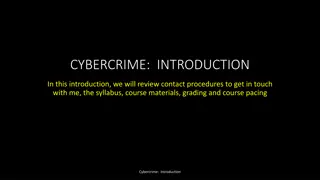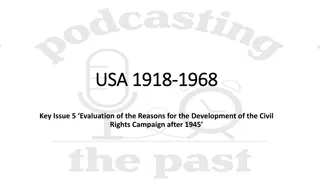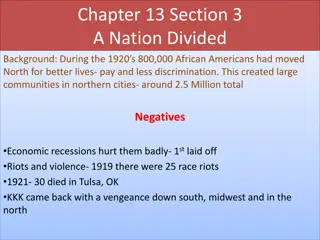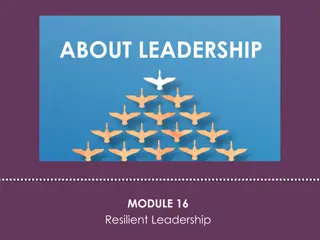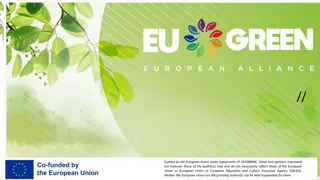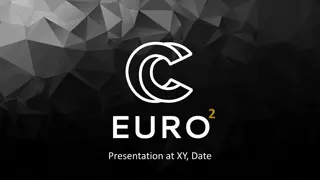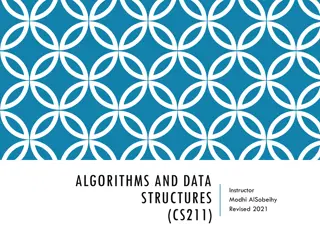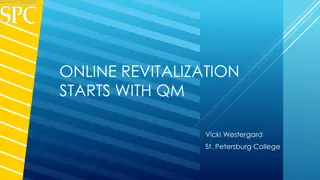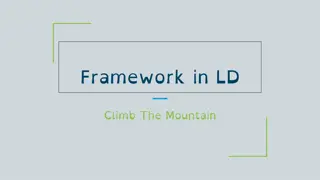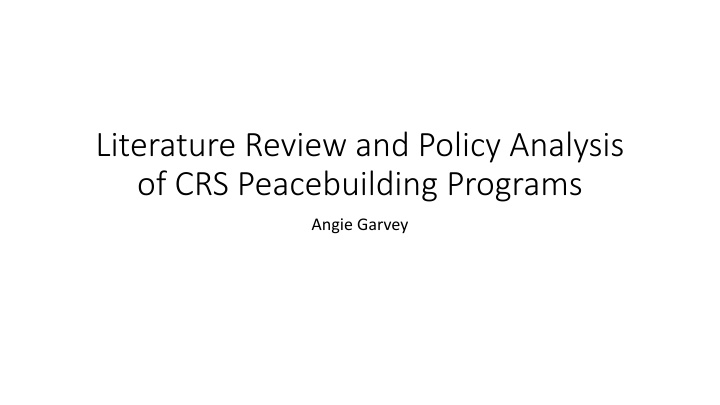
Policy Analysis & Impediments in CRS Peacebuilding Programs
Explore the literature review and policy analysis of CRS peacebuilding programs by Angie Garvey, focusing on cultural factors influencing youth involvement in conflict management, integration of peacebuilding in education projects, and reported impediments to participation. Discover methodologies, barriers to participation, and evaluation criteria that address key aspects of conflict resolution and youth engagement.
Download Presentation

Please find below an Image/Link to download the presentation.
The content on the website is provided AS IS for your information and personal use only. It may not be sold, licensed, or shared on other websites without obtaining consent from the author. If you encounter any issues during the download, it is possible that the publisher has removed the file from their server.
You are allowed to download the files provided on this website for personal or commercial use, subject to the condition that they are used lawfully. All files are the property of their respective owners.
The content on the website is provided AS IS for your information and personal use only. It may not be sold, licensed, or shared on other websites without obtaining consent from the author.
E N D
Presentation Transcript
Literature Review and Policy Analysis of CRS Peacebuilding Programs Angie Garvey
Research Questions Cultural factors and youth involvement in Conflict Management and Mitigation (CMM) structures Which significant cultural factors influence youth involvement in conflict resolution mechanisms? What considerations should CRS put in place to design effective programs that address the negative effects of these cultural factors? Integration of peace building in Education project What interventions should CRS implement to address peace building concerns among communities where it is implementing education programs in Sudan? What role can communities play in mitigating effects of conflict on education projects?
Methodology Databases Science Direct, Web of Science, PAIS, CIAO Grey Literature Administrative Sources SOAR Higher and Promoting Trust Programs
Reported Impediments to Participation 1. Farmer youth most affected by violent conflict 2. Education interventions unable to reach the most marginalized youth 3. Insufficient interaction between farmer and pastoralist youth 4. Primarily adult male membership of conflict resolution committees 5. Communal push-back against increased female youth participation
Barriers to Participation & Cultural Factors Farmer youth most affected by violent conflict 1. Tension and isolation between Education interventions unable to reach the most marginalized youth farmer and pastoralist Insufficient interaction between farmer and pastoralist youth communities Primarily adult male membership of conflict resolution committees 2. Entrenched tradition of adult Communal push-back against increased female male leadership youth participation
Evaluation Criteria Evaluation Criteria Cultural Factor Addresses the most isolated and at risk youth. Tension and Isolation between farmer and pastoralist communities Promotes youth leadership and ownership. Entrenched tradition of adult male leadership Is gender sensitive. Entrenched tradition of adult male leadership
1: Status Quo Farm Protection Committees Resource Management Committees Savings and Internal Lending Committees Accelerated Learning Program Youth Environmental Protection Club Isolated and at risk youth Low Youth leadership and ownership High Gender sensitivity Low
2: Youth-led participatory research Young people are trained to conduct systematic research on conflict Dual purpose: An opportunity to develop knowledge and skills An analysis the security context in a given location Isolated and at risk youth Medium Youth leadership and ownership High Gender sensitivity Medium
3: Team sports for pastoralist youth Entry point to peacemaking Forum for non-violent rivalry and competition Creates space for farmer-pastoralist youth interaction Isolated and at risk youth High Youth leadership and ownership Medium Gender sensitivity Low
4: Community-consulted intergenerational exchanges Strengthen the connection between youth and existing leadership Focus on intergenerational participation of multiple groups Especially female youth Isolated and at risk youth Medium Youth leadership and ownership High Gender sensitivity High
Youth Participation in Peacebuilding Options Isolated and at risk youth Low Youth leadership and ownership High Gender sensitivity Low Status Quo Youth-led participatory research Sports activities Medium High Medium High Medium Low Community-consulted intergenerational exchanges Medium High Medium
Recommendation Isolated and at risk youth High Youth leadership and ownership Medium Gender sensitivity Low Sports activities Community-consulted intergenerational exchanges Medium High High Do both High High Medium
Causes of Insecurity Immediate Drivers of Conflict Returning of IDPs Regional Conflict Trends Declining Economy Long-Term Causes of Conflict Erosion of Natural Resources Population Growth War in 2003 Legal Inequalities
1: Status Quo Farm Protection Committees Resource Management Committees Savings and Internal Lending Committees Gender sensitivity trainings Technical feasibility Political Viability Administrative Operability Cultural and Contextual Appropriateness Medium Low Medium High
2: Early Warning Early Response (EWER) System Data collection on conflict indicators Risk analysis Dissemination of information with recommendations to stakeholders Supports existing conflict prevention structures Technical feasibility Political Viability Administrative Operability Cultural and Contextual Appropriateness Low Medium High Medium
3: Community-based forums with differentiated women s meetings Bring together different groups within communities Rebuild trust and confidence among community members Space to support and provide feedback on project interventions Technical feasibility Political Viability Administrative Operability Cultural and Contextual Appropriateness Low Medium High High
4: Community-led participatory research Ownership of understanding conflict and avenues of conflict resolution Information can be shared with CRS researchers and program staff Incorporates local voices in programming Technical feasibility Political Viability Administrative Operability Cultural and Contextual Appropriateness Low High Medium High
Community-based Conflict Resolution Options Technical feasibility Political Viability Administrative Operability Cultural and Contextual Appropriateness Medium Status Quo Low Medium High Early Warning Early Response (EWER) Low Medium High Medium Community-based forums with differentiated women s meetings Community-led participatory research Low Medium High High Low High Medium High
Recommendations Technical feasibility Political Viability Administrative Operability Cultural and Contextual Appropriateness High Community-based forums with differentiated women s meetings Community-led participatory research Do both Low Medium High Low High Medium High Low Medium Low High



